| Pages:
1
..
4
5
6
7
8
..
11 |
chloric1
International Hazard
    
Posts: 1142
Registered: 8-10-2003
Location: GroupVII of the periodic table
Member Is Offline
Mood: Stoichiometrically Balanced
|
|
| Quote: | Originally posted by 12AX7
Washing and recrystallization. Or I suppose NaOH (covert to CrO4(2-)), H2O2 (peroxychromate complex) and acidify (decomposes to Cr(III)) to neutral
(precipitates Cr(OH)3) would be an acceptable alternative.
Fine precipitates (of KClO3) are hard to clean by mere washing and recrystallization; the last batch I handled was just barely perceptibly green when
dried. Oh well, it's only a few ppb of the stuff!
Tim |
I know its not alot but the yellow color is REALLY annoying! Here is my electrolytic urine 
[Edited on 9/14/2007 by chloric1]
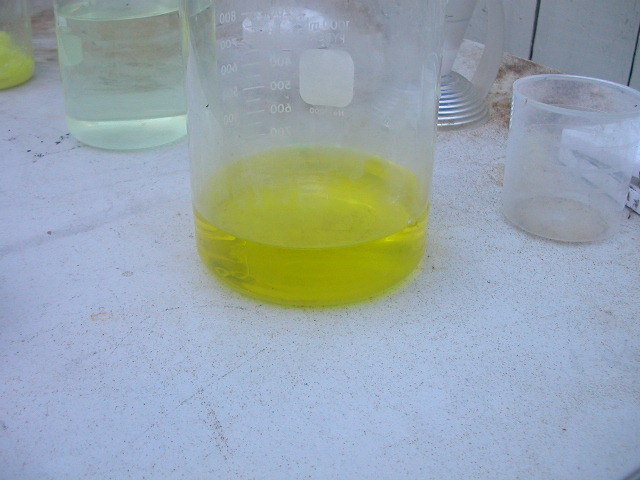
Fellow molecular manipulator
|
|
|
chloric1
International Hazard
    
Posts: 1142
Registered: 8-10-2003
Location: GroupVII of the periodic table
Member Is Offline
Mood: Stoichiometrically Balanced
|
|
Precipitation
Barium chloride
I don't know why I did not think of this sooner! 
Barium chloride forms very insoluble barium chromate which precipitates and leaves a clear fluid on top. Some barium goes into solution but the
remainder seems to drop out during boiling and concentrating. Just be sure to separate this before the solutions cools. Here is the resulting
solution after barium treatment. I am waiting for crystallization right now in the freezer.
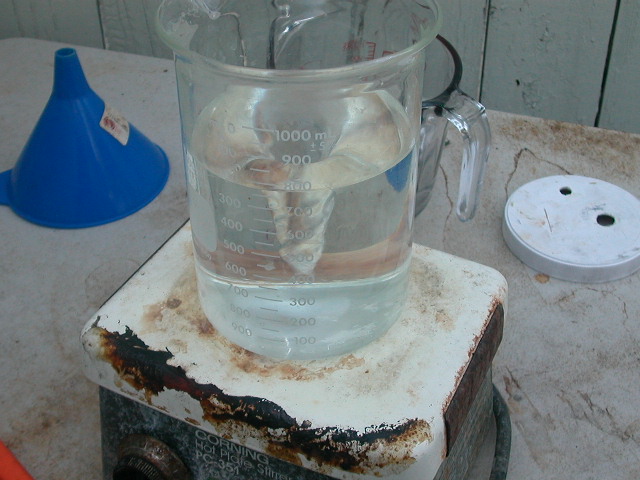
Fellow molecular manipulator
|
|
|
12AX7
Post Harlot
    
Posts: 4803
Registered: 8-3-2005
Location: oscillating
Member Is Offline
Mood: informative
|
|
Since I do this continuously, I remove the material and leave the chrome in place. I have a whole bucket (about 5 gallons) approximately that color.

...That would be a lot of urine...
Tim
|
|
|
chloric1
International Hazard
    
Posts: 1142
Registered: 8-10-2003
Location: GroupVII of the periodic table
Member Is Offline
Mood: Stoichiometrically Balanced
|
|
Continuous Process
Tim,
Actually that was about a fourth of what I had but still not close to the level that your running. Plus my final chlorate yeilding solution has been
crystalized and redissolved about twice now. There should be very little sodium chloride now. I am nowhere near production on a continous basis but
I have a working knowledge of solubility and crystal behaviour. The real key here is there is very change in sodium chloride solubility at various
temperatures.
Fellow molecular manipulator
|
|
|
chloric1
International Hazard
    
Posts: 1142
Registered: 8-10-2003
Location: GroupVII of the periodic table
Member Is Offline
Mood: Stoichiometrically Balanced
|
|
Chlorate crystal
OK this my final result. After spending the night in the freezer at 20 below zero Celcius, I got these crystals with peculiar cubic characteristics
different than sodium chloride cubes. The cluster in my hand has a notably large cube face so I tried to capture the suns reflection with it for
photo drama  . .
@Tim,
Even with HUGE volumes of crude product like you have, the actual quantity of barium choride would be small in comparison. You may only want to do a
few smal batches if you wanted purified chlorate for a specific use or crystal study. Great thing to do next time you have downtime.
[Edited on 9/15/2007 by chloric1]
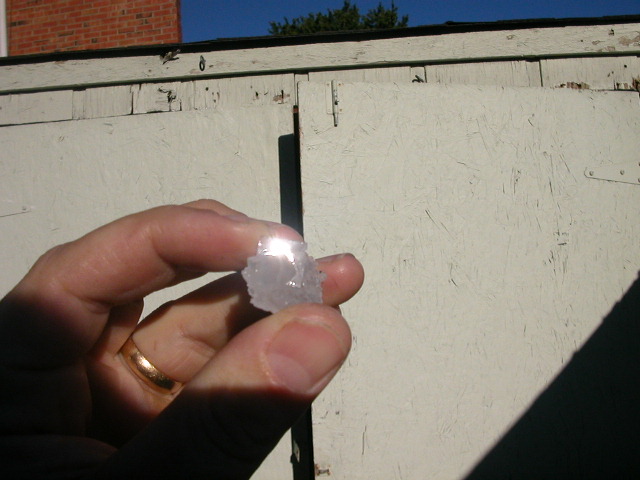
Fellow molecular manipulator
|
|
|
12AX7
Post Harlot
    
Posts: 4803
Registered: 8-3-2005
Location: oscillating
Member Is Offline
Mood: informative
|
|
Nice sample. 
I have some crystals like that. None of them as large, but I do have a few which formed over several days which are very clear, and clearly cubic in
shape. Remarkably, most of these sorts of crystals are formed in raw yellow solution, yet they are hardly colored.
When rapidly cooling from a boiling, saturated solution, I get a hard bed of stepped, rounded (not quite polygonal) crystals that's hard to break up.
(It seems to me a lot of very soluble substances do this.) The difference is probably the temperature of spontaneous seeding and, especially in
regards to clear crystals, the cooling rate.
Tim
|
|
|
Xenoid
National Hazard
   
Posts: 775
Registered: 14-6-2007
Location: Springs Junction, New Zealand
Member Is Offline
Mood: Comfortably Numb
|
|
| Quote: | Originally posted by chloric1
OK this my final result. After spending the night in the freezer at 20 below zero Celcius, I got these crystals with peculiar cubic characteristics
different than sodium chloride cubes. The cluster in my hand has a notably large cube face so I tried to capture the suns reflection with it for
photo drama  . .
[Edited on 9/15/2007 by chloric1] |
This is a bit off topic, but sodium chlorate was a popular choice for crystal growing recipes in more enlightened times. It is very easy (like alum)
to grow large perfectly formed crystals. Now, if only I could find my crystal growing book (damn kids!) there is a lovely photo showing this!
Edit: Ah! Finally found it! It was in a kitchen cupboard with the crystal growing chemicals! Interestingly they mention that if the growing solution
has 6g borax for every 100g chlorate, you can entirely suppress the growth of the cubic faces and the crystal will take on the tetrahedral shape! So
perhaps the more cubic shaped your crystals are is an indication of purity.
Regards, Xenoid
[Edited on 15-9-2007 by Xenoid]
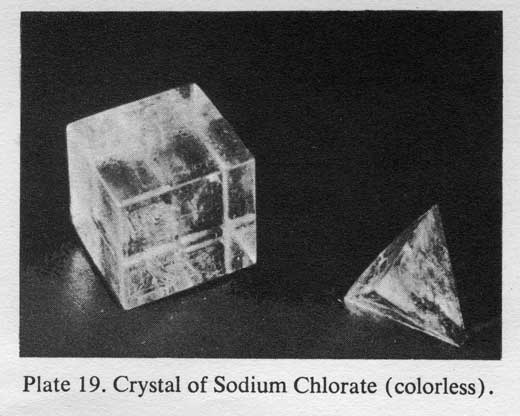
|
|
|
chloric1
International Hazard
    
Posts: 1142
Registered: 8-10-2003
Location: GroupVII of the periodic table
Member Is Offline
Mood: Stoichiometrically Balanced
|
|
Chlorate purity
Well, That what I think and hope. I am going to bottle what little I have now. Whatever did not crystallize is mixed back with brine and I started
the cell again at 7pm EDT. If it is not 99% pure it is damn close! I put some in a test tube and added drops of conc. HCl and it turned BRIGHT
yellow and gave copious noxious fumes. I am certain it was chlorine dioxide mixed with free chlorine. Elemental chlorine when in any solution is
dumped into large water is almost immediately dispersed. This yellow color stayed persistant for a while and had to be agitated to disperse
indicating it's density amongst other qualities.
[Edited on 9/15/2007 by chloric1]
Fellow molecular manipulator
|
|
|
The_Davster
A pnictogen
      
Posts: 2861
Registered: 18-11-2003
Member Is Offline
Mood: .
|
|
I was curious about how much current Pt could handle.
So...anode and cathode both 0.3cmx0.8cm Pt foil. Assuming only the area of the electrodes that are closest together have the majority of current
flowing through them, that gives an effective surface area of 0.24cm<sup>2</sup>. 4.5A was run through these electrodes for 6h, the cell
stabilized at 85C. Current density=18.75A/cm<sup>2</sup>.
Funny thing is, the electrode that was badly dissolved was the - cathode Which
is very odd, it should have been protected from dissolving, any dissolution should have taken place at the anode, which is still perfect. I have
looked for all sources of me making an error and confusing the two electrodes, but I took pictures at the beginning, and it was hooked up the way I
think, and a voltmeter was attached indicating that my - and + leads were the ones that I thought they were. Which
is very odd, it should have been protected from dissolving, any dissolution should have taken place at the anode, which is still perfect. I have
looked for all sources of me making an error and confusing the two electrodes, but I took pictures at the beginning, and it was hooked up the way I
think, and a voltmeter was attached indicating that my - and + leads were the ones that I thought they were.
How strange.
Now the challenge..cleaning PtO2 off glassware...Hopefully peroxide/HCl works.
[Edited on 22-9-2007 by The_Davster]
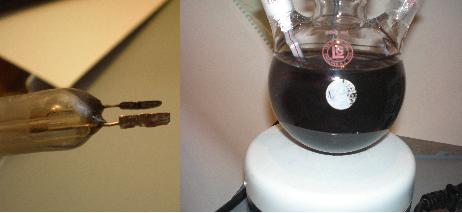
|
|
|
Xenoid
National Hazard
   
Posts: 775
Registered: 14-6-2007
Location: Springs Junction, New Zealand
Member Is Offline
Mood: Comfortably Numb
|
|
According to Dann2's site, 600 mA/cm^2 is considered high by industrial standards for Pt electrodes in a perchlorate cell, that's 6000 A/m^2. Now
18.75 A/ cm^2 that's 187500 Amps/m^2. I'm surprised you had anything left at all!... 
Regards, Xenoid
|
|
|
The_Davster
A pnictogen
      
Posts: 2861
Registered: 18-11-2003
Member Is Offline
Mood: .
|
|
Yes, I was expecting heavy wear!...of the anode...
The anode was perfect after doing this. The cathode should have been protected by the (verystrong)negative charge on it, but yet it wore down as
opposed to the anode.
I am wondering if the black junk is platinum dioxide or some sort of very very fine platinum particles which were somehow ejected from the electrode.
|
|
|
Xenoid
National Hazard
   
Posts: 775
Registered: 14-6-2007
Location: Springs Junction, New Zealand
Member Is Offline
Mood: Comfortably Numb
|
|
What was your electrolyte, NaCl solution or acidified water?
If you have black material, I would suggest it is "platinum black", ie. finely divided platinum with interesting occluding properties, etc.
Regards, Xenoid
|
|
|
The_Davster
A pnictogen
      
Posts: 2861
Registered: 18-11-2003
Member Is Offline
Mood: .
|
|
Yes, it was saturated NaCl, I was doing this experiment to see how well Pt electrodes under high current density in a chlorate cell would hold up.
Pt black would be more expected from the cathode than platinum dioxide.
|
|
|
Eclectic
National Hazard
   
Posts: 899
Registered: 14-11-2004
Member Is Offline
Mood: Obsessive
|
|
Maybe the current density was so high you got spark erosion or bubble cavitation? (ultrasonic erosion)
High hydrogen loading of the Pt with surface spalling?
[Edited on 9-23-2007 by Eclectic]
|
|
|
ciscosdad
Hazard to Self
 
Posts: 76
Registered: 6-2-2007
Member Is Offline
Mood: Curious
|
|
Crystal growing
@ Xenoid
This crystal pics you posted look great.
What was the name of the book? I was fascinated by the reference ro Borax in NaClO3 to give tetrahedrons. It makes me wonder what other delightful
little insights are there.
|
|
|
Xenoid
National Hazard
   
Posts: 775
Registered: 14-6-2007
Location: Springs Junction, New Zealand
Member Is Offline
Mood: Comfortably Numb
|
|
@ Ciscosdad
It's an oldie! But I've seen some of the "recipes" published on various crystal growing websites.
Crystals and Crystal Growing by Alan Holden & Phylis Singer.
Published by Heinemann, 1st Published Great Britain 1961.
I bought my paperback copy in the mid 60's from Verity Hewitt in Canberra for 13 shillings and 3 pence! 
I'm not sure if there are anymore interesting titbits in it, I only noticed the borax reference when I was looking up the NaClO3. It is interesting
though, to experiment with growing crystals and deliberately introduce various amounts of ions with the same charge but differing ionic radii so they
are incorporated into the lattice but cause distortion and change the growing habit.
There is an appendix with about 10 amateur "research" topics.
EDIT: I just googled it, it is still available. Looks like Phylis got married and is now Phylis Morrison!
Regards, Xenoid
[Edited on 23-9-2007 by Xenoid]
|
|
|
ciscosdad
Hazard to Self
 
Posts: 76
Registered: 6-2-2007
Member Is Offline
Mood: Curious
|
|
The book!
Thanks Xenoid.
I now have the book, thanks to you and Amazon, and it looks amazingly interesting.
Ref P2P's
I note the changes in crystal shape due to copper/alkali doping. I just gotta try that.
|
|
|
ciscosdad
Hazard to Self
 
Posts: 76
Registered: 6-2-2007
Member Is Offline
Mood: Curious
|
|
Power supplies
I have read with envy of Tim's run at 60A. Unhappily most of us do not have access to these sorts of currents.
Is it possible to parallell 3 PC PSU's at (say) 20A to get the same result?
I know that there is a potential problem balancing them, but could the differences be swamped (if you like) if there were a separate electrode
assembly for each PSU all in the same bucket of electrolyte? I would assume that the small solution resistances between the arrays would damp the
potential problems but my electronics theory is not that good.
|
|
|
12AX7
Post Harlot
    
Posts: 4803
Registered: 8-3-2005
Location: oscillating
Member Is Offline
Mood: informative
|
|
No.
Just build three cells 
Tim
|
|
|
dann2
International Hazard
    
Posts: 1523
Registered: 31-1-2007
Member Is Offline
Mood: No Mood
|
|
Hello,
Building three cells or using three sets of electrodes needs three anodes. If using Graphite that's not too much of a problem but if using something
more exotic, three anodes may not be to hand.
(Assuming three ATX supplies): If you were to use one (available) anode and three different cathodes. All the positives connected to anode. Each of
the three neg's to each cathode.
Perhaps that would be a good compromise if you do not have three Anodes. A diode in each power supply would be essential IMHO. The diode would also
help to balance current as the voltage will rise accross it (a small amount) as current increases helping setup to have the current more evenly
distributed between supplies. You could also have a low value resistor in each supply for to measure current coming from each supply (volt drop
accross resistor) and adjust the cathodes to give sensible (~one third) currents from each supply.
Would it work though??
I obtained 6 computer power supplies to experiment with, in parallel, some time ago but never got around to doing anything yet.
Dann2
|
|
|
12AX7
Post Harlot
    
Posts: 4803
Registered: 8-3-2005
Location: oscillating
Member Is Offline
Mood: informative
|
|
Ah, that should work. As long as the cathodes are widely seperated, they won't be prone to corroding each other.
I prefer using the steel housing as cathode, which obviously wouldn't be very amenable to such a solution 
A diode will prevent current backflow (which would otherwise cause the internal regulator to throttle down or cut off, as it does when lightly
loaded), but it will not encourage current sharing. A diode has a steep rate of current vs. voltage, little better than the power supplies
themselves. To share current, you need each supply to be a constant current source, of which a series resistor is a rough, wasteful approximation.
(You need to drop voltage anyway (typical cell operating around 3-4V), so it's not all that bad.)
Tim
|
|
|
ciscosdad
Hazard to Self
 
Posts: 76
Registered: 6-2-2007
Member Is Offline
Mood: Curious
|
|
3 Supplies
When I visualised this I had 3 totally independent electrode sets (gouging carbons and Stainless steel) in mind. The only connection between the 3 is
the resistance of the solution.
Current measurement is a 0.01 ohm resistor in series with each supply and a cheapo Digitial multimeter that will read the voltage across the resistor
to give an indication of current.
Looks like that will help the current matching.
Thanks for your input guys.
BTW. This last few posts may be better in the PSU's thread if any of the moderators prefer to switch it. My fault; I should have posted there in the
first place.
|
|
|
dann2
International Hazard
    
Posts: 1523
Registered: 31-1-2007
Member Is Offline
Mood: No Mood
|
|
Hello,
Don't forget to come back and tell us how it went....or didd'nt.
You could always put a loose plastic baffle between the sets of electrodes to isolate them some more from each other. Nearly three different cells but
not quite.
Dann2
|
|
|
JohnWW
International Hazard
    
Posts: 2849
Registered: 27-7-2004
Location: New Zealand
Member Is Offline
Mood: No Mood
|
|
NaClO3 crystals
| Quote: | Originally posted by Xenoid
Chloric:
OK this my final result. After spending the night in the freezer at 20 below zero Celcius, I got these crystals with peculiar cubic characteristics
different than sodium chloride cubes. The cluster in my hand has a notably large cube face so I tried to capture the suns reflection with it for
photo drama  . (Chloric) . (Chloric)
This is a bit off topic, but sodium chlorate was a popular choice for crystal growing recipes in more enlightened times. It is very easy (like alum)
to grow large perfectly formed crystals. Now, if only I could find my crystal growing book (damn kids!) there is a lovely photo showing this!
Edit: Ah! Finally found it! It was in a kitchen cupboard with the crystal growing chemicals! Interestingly they mention that if the growing solution
has 6g borax for every 100g chlorate, you can entirely suppress the growth of the cubic faces and the crystal will take on the tetrahedral shape! So
perhaps the more cubic shaped your crystals are is an indication of purity.
Regards, Xenoid |
As I remember, in crystallographic notation, the cubic cleavage planes of isometric- or cubic-system (and also tetragonal and orthorhombic) crystals
are (100) (as in NaCl), the octahedral and tetrahedral cleavage planes are (111), the rhombic dodecahedral planes (as seen in garnet) are (110), and
the pyritohedral planes (as seen in the irregular-pentagonal dodecahedral form of cubic FeS2) are (210), to name the most commonly-seen crystal forms.
There are five different cubic symmetry class - there is holosymmetric or spherically symmetric or hexoctahedral (like NaCl, CaF2, diamond, Cu, Ag,
Au, AgCl, spinel) with identical symmetry in all 3 dimensions, the diploidal or pyritohedral (like FeS2), the hextetrahedral (like spalerite), the
gyroidal (like Cu2O), and tetartoidal which is the least symmetric.
The symmetry class has a strong effect on the crystal form, i.e. macromorphology, of a compound that is most commonly seen; see
http://www.galleries.com/minerals/symmetry/isometri.htm . and http://www.uwgb.edu/dutchs/symmetry/xlforms.htm
There are a total of 7 crystal systems, 32 symmetry classes, and 48 special crystal forms.
See this ebook on crystal systems: http://homepage.mac.com/whitby/.Public/CrystalBook.pdf
In the case of NaClO3 and NaBrO3, they belong to the cubic tetartohedral class, and exhibit optical activity which is characteristic of that
least-symmetrical cubic symmetry class. By contrast, NaCl belongs to the most symmetrical cubic class.
See: http://dx.doi.org/10.1107/S0365110X57002327
- if anyone can download it, please.
This property has led to its use as a new crystal in Raman-spectrum lasers, http://adsabs.harvard.edu/abs/1998ApPhB..67..157K
Here is a reference on growing NaClO3 crystals from aqueous solution: http://www.crystalresearch.com/crt/ab34/661_a.pdf
|
|
|
The_Davster
A pnictogen
      
Posts: 2861
Registered: 18-11-2003
Member Is Offline
Mood: .
|
|
Thinking of trying out a design for a chlorate cell...
Alfa Aesar sells a 20 mesh titanium gauze(made from0.003in wire).
Thinking of one of those wrapped in a cylinder form around a graphite anode.
Is the wire used in this mesh(their cheapest Ti mesh ) too thin at all? It should
not dissolve at all, but I usually prefer something beefier. ) too thin at all? It should
not dissolve at all, but I usually prefer something beefier.
|
|
|
| Pages:
1
..
4
5
6
7
8
..
11 |